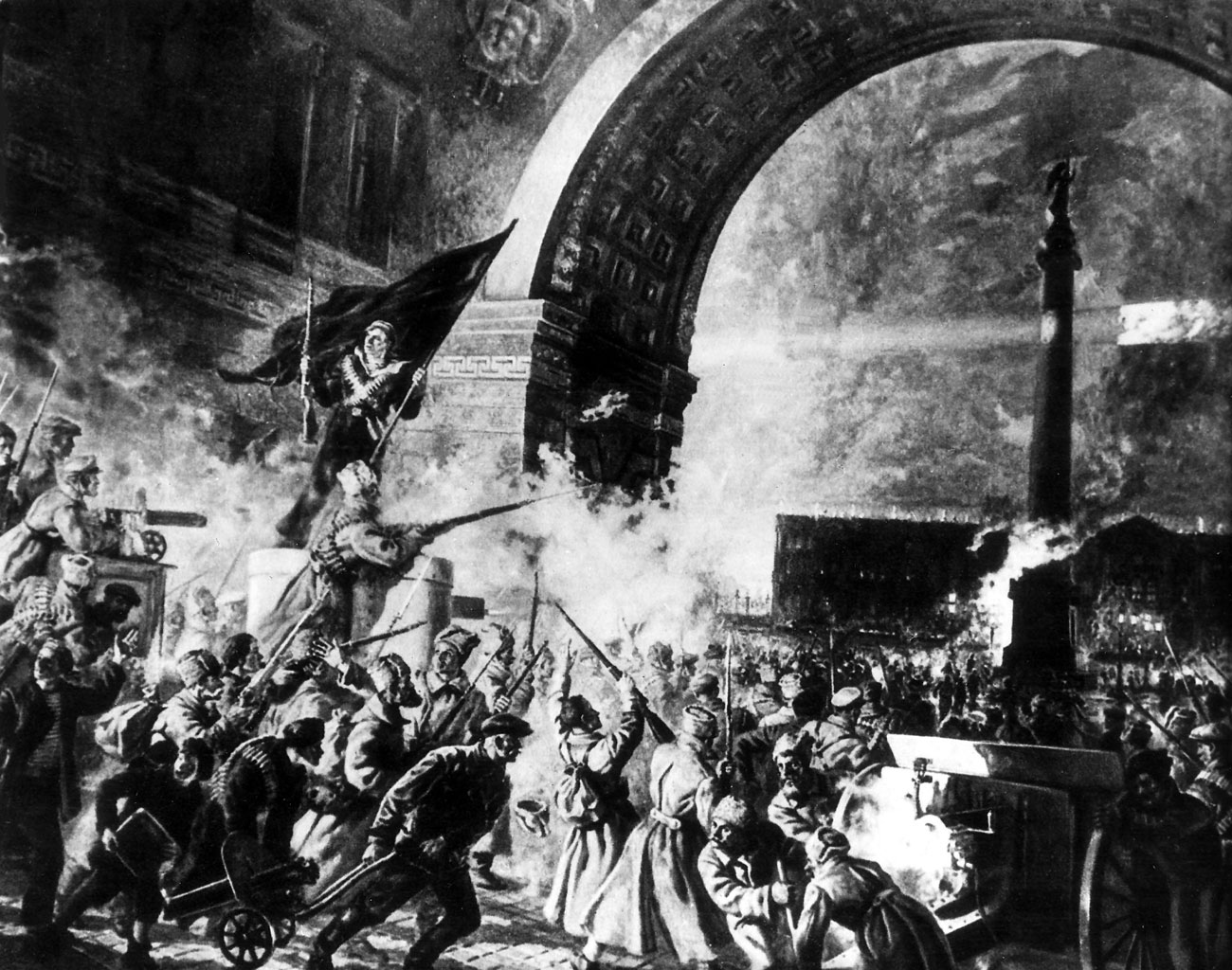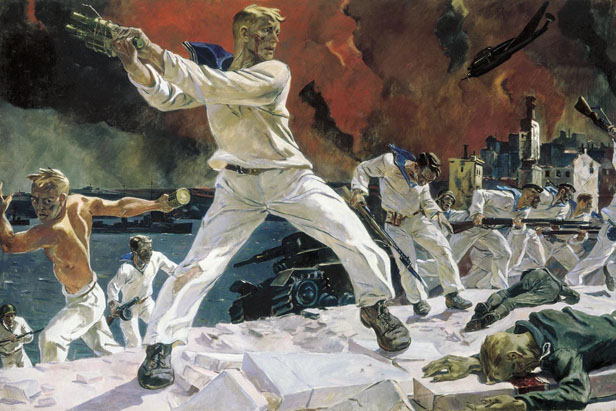Seeing a new world: Art born of the Bolsheviks
 'Storming the Winter Palace
on October 25' by
PP Sokolov-Skalya (1889–1961). Source: Ullstein Bild / Vostock Photo
'Storming the Winter Palace
on October 25' by
PP Sokolov-Skalya (1889–1961). Source: Ullstein Bild / Vostock Photo
Russian society still does not have an unambiguous understanding of the 1917 Revolution. On the eve of the event's 100th anniversary the mass media frequently presents discussions on what it was exactly that the Revolution gave Russia and the world. However, the October Revolution overturned not only Russia's political but also its artistic order. For several years the avant-garde's utopia became reality. The democratization of the education system, as well as of the exhibition and museum sphere reached an unprecedented level. Many Western artists were astounded by the events in Russia and for many years were enchanted with revolutionary ideas.
Revolutionary reforms occurred on all levels. Artistic education became maximally democratic and above all, free. The former Academy of Arts in St. Petersburg was renamed the Free Workshops. Artists exhibited their work right on the street and anyone passing by could participate in the seminars. In Vitebsk Kazimir Malevich organized the University of New Art, an association that formed an entire generation of suprematists. The idea of authorship was completely abandoned. Students exhibited their works unsigned, including Malevich himself. And this was in the 1920s!
Leftist artists began actively collaborating with the state. Malevich, Kandinsky, Tatlin and Rodchenko worked in the Visual Arts Department of the Education Ministry. The state had chosen the avant-garde as the revolution's new language; it radically differed from traditional "bourgeois" art. The celebration of the first anniversary of the revolution was arranged by Nathan Altman, who covered the Hermitage with red calico and decorated the Alexandrinsky Column with Suprematist forms.Art institutes were established to develop the theory of the new art. The visual arts department at the education ministry proposed to unite all avant-garde artists in the Communist International. In 1921 the Institute of Artistic Culture recognized painting as a bourgeois art. From that moment on the artist had to direct his skills to creating things.
Latin connections
The influence of the October Revolution and its ideas spread throughout the world, not only to Europe but also to Latin America. And often these ideas were applied to receptive artistic cultures. By the time of the revolution in Russia, Mexicans had been battling for a democratic constitution and the nationalization of their land. Artists David Alfaro Siqueiros and José Clemente Orozco personally participated in the revolutionary events in their country and therefore welcomed the Russian Revolution with enormous sympathy. The Mexicans were developing the new "folk" art inspired by Socialist ideas. "Everything that we went through and realized in art is substantial, is very important, but it is just the beginning, the beginning of a great path to the happiness of mankind, the first step to which was taken by Lenin, the Great October Revolution," Siqueiros wrote in his autobiography.
Diego Rivera worked in the USSR in 1927-1928. There he co-founded the October Association, where he collaborated with painters Alexander Deyneka and Dmitri Moor, architects Leonid, Victor and Alexander Vesnin and film director Sergei Eisenstein. Returning to Mexico, Rivera began his magnum opus, The History of Mexico mural at the National Palace in Mexico City. However, his most scandalous declaration of love to the Russian Revolution was the mural of Lenin surrounded by workers in Rockefeller Center, New York, which was destroyed by the client shortly afterward.Leftist ideas were also dear to French surrealists. However, they proposed to start the revolution in their consciousness. They thought that the main instrument of liberation was art, although they did admire the idea of a world revolution. "We were bewitched by the triumph of the Russian revolution and the creation of a workers' state led to a big change in our views," wrote André Breton in a 1952 article. Swept away by the new utopia, the surrealists issued the "Revolution first of all and forever" declaration, calling on a radical social alteration. In January 1927 five Surrealists - Breton, Aragon, Eluard, Unik and Péret - joined the Communist Party.
Bauhaus influence
The German Bauhaus, an art school in which many teachers shared extreme leftist political views, also welcomed the society of equal opportunity. Fresh news from Russia came to Germany via Vasily Kandinsky and El Lissitzky, who emigrated from Russia in 1921. Kandinsky headed the painting and fresco workshop, while Lissitzky promoted Kazimir Malevich's suprematist compositions in Germany.
Bauhaus artists and architects, just like their colleagues in the Vkhutemas art and technical school in Moscow, thought that the new art would help build a happy future for humanity. This idea led to interest in mass standard housing. Bauhaus' second director Hannes Meyer came to the USSR with his students and headed an architectural firm that developed general plans for new cities. In Meyer's view, which he later called the "New Theory of Construction," the urban space's functionality and organization was given priority. In the standard micro-neighborhoods it was planned in advance where people would live, study, converse with their friends and where they would do sports.
The town of Birobidzhan was partially built according to Meyer's designs. However, Meyer and his colleagues were not able to work long in the suffocating environment of the 1930s and in 1937 he left the USSR. But for a long time his ideas were still perceived as a potential direction for developing contemporary cities and even influenced European postwar housing.
The surrealists were also disillusioned by the revolutionary events in Russia. Trotsky's exile sowed doubt in the values of the revolution. Surrealist artists were perplexed by the evolution of the Soviet government, which was becoming more and more totalitarian. After clashing with the French Communist Party, Breton left the Communist ranks in 1933. Subsequently, in Mexico he contacted Lev Trotsky and Diego Rivera and published the For Independent Revolutionary Art Manifesto, which defended anarchic intellectual freedom without limits. The revolution, Breton considered, was in no way supposed to result in a society "where everyone, like in Russia, is equal in slavery."
All rights reserved by Rossiyskaya Gazeta.
Subscribe
to our newsletter!
Get the week's best stories straight to your inbox

